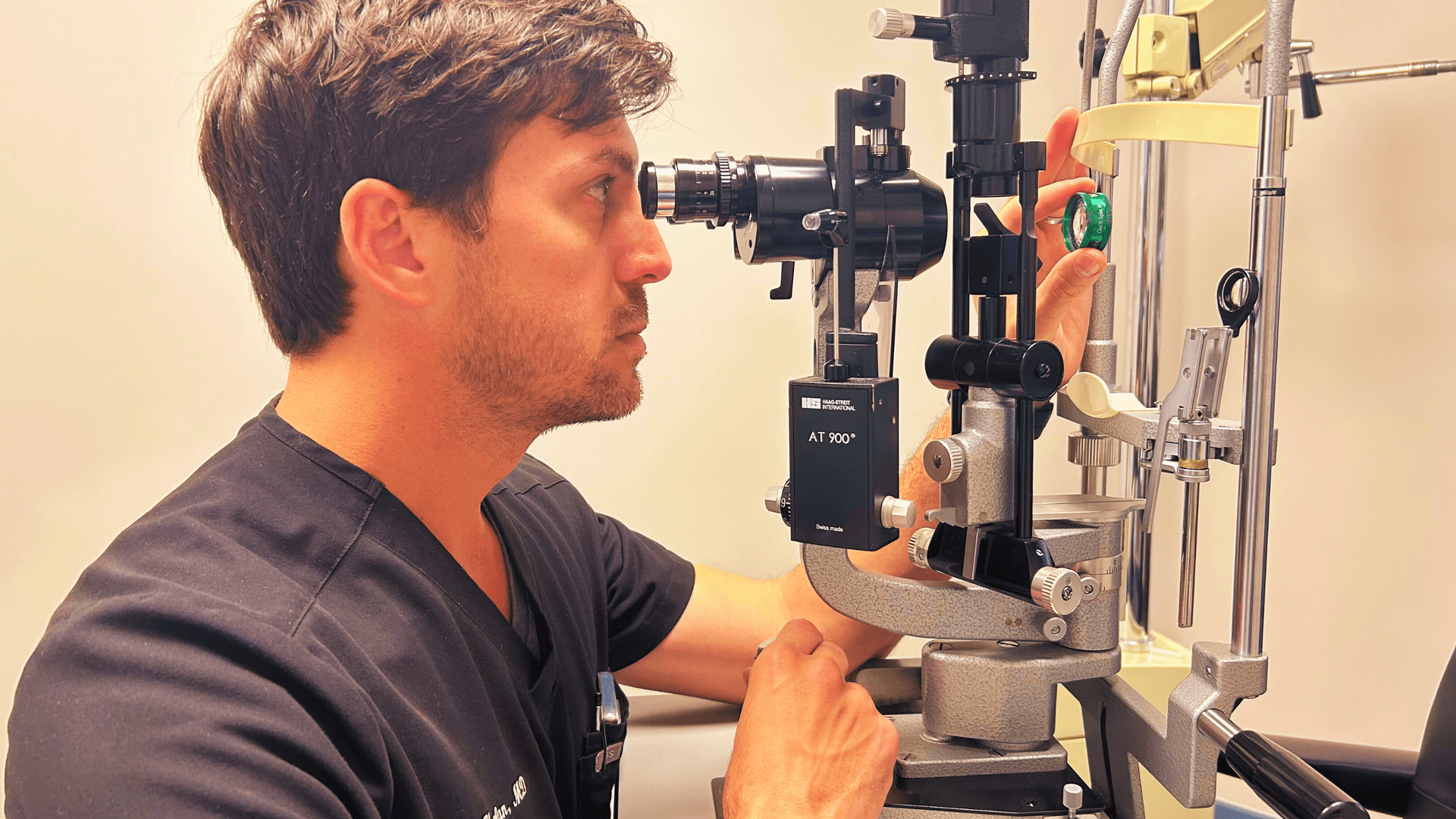Follow Us
10 Street Name, City Name
Country, Zip Code
786-829-6395
contact@ophthalmologistmiami.com
Glaucoma Surgery: Modern Tech for Healthy Eyes
Glaucoma is one of the leading causes of irreversible blindness worldwide. It damages the optic nerve and gets worse over time if left untreated. Early detection and timely treatment are critical to prevent vision loss.
Glaucoma causes increased pressure inside the eye, and glaucoma surgery aims to reduce this intraocular pressure to preserve sight. Surgery is recommended when medications and laser procedures fail to lower eye pressure sufficiently.
There are two main types of glaucoma surgery:
- Minimally invasive glaucoma surgeries (MIGS) - microincisions, shorter recovery
- Conventional surgeries - trabeculectomy, tube shunts, higher efficacy
Surgeries can be done alone or combined with cataract surgery. Modern techniques allow faster recovery with same-day discharge. They are highly effective at lowering eye pressure with minimal complications.
This article will provide a comprehensive overview of the latest developments in glaucoma surgery and what to expect before, during, and after your procedure. We will also discuss selecting the right glaucoma specialist and how to navigate insurance coverage and out-of-pocket costs.
Glaucoma Surgery Techniques
Now that we've got the basics covered, let's explore the different types of glaucoma surgery options. I'll explain each method, along with the pros and cons, so you can understand the range of treatments available.
First up, we have minimally invasive glaucoma surgeries, or MIGS. These use tiny incisions - just 1 to 3 millimeters wide. MIGS procedures involve inserting a microscopic device or implant to help drainage and lower eye pressure gently over time.
Minimally Invasive Glaucoma Surgeries (MIGS)
MIGS are revolutionary because they're so gentle on the eye. You'll have a much faster recovery time, usually getting back to normal within days or weeks. The microsurgeries also have lower risks of complications compared to conventional glaucoma operations.
Here are some of the most common MIGS techniques:
- XEN implant - This collagen device is 6mm long and smaller than an eyelash! It creates a drainage channel from the eye's interior to the subconjunctival space. The XEN stent lowers pressure with minimal tissue disruption.
- iStent - Don't let the size fool you. This 1mm long titanium implant fits into the eye's natural drainage canal, called the Schlemm's canal. Once inserted, the iStent improves fluid outflow.
- Hydrus - Looking like a mini scoop, this crescent-shaped implant dilates the drainage canal to reduce pressure. It expands the eye's fluid outlets.
- CyPass - Resembling a tiny tube, this device is inserted into the supraciliary space. It forms an alternative drainage pathway to lower eye pressure.
- Laser procedures - Selective laser trabeculoplasty (SLT) and micropulse laser trabeculoplasty (MLT) target the trabecular meshwork to improve fluid flow.
As you can see, there are lots of options! Your ophthalmologist will determine which MIGS procedure is best suited for your eye anatomy and extent of glaucoma. Many can be done right in the doctor's office.
The biggest pro for MIGS is the faster recovery with minimal downtime. You can expect clearer vision and pressure reduction quickly, often within a week or two. MIGS presents lower risks than conventional surgery. And they can be combined with cataract removal as an all-in-one procedure.
Downsides are that MIGS don't decrease eye pressure to the same level as traditional glaucoma operations. Patients may eventually need another surgery to control glaucoma progression. And insurance doesn't always cover MIGS.
Conventional Glaucoma Surgeries
If MIGS don't sufficiently reduce your eye pressure, traditional surgical options bring out the big guns. They aim for greater pressure reduction to halt glaucoma damage.
Conventional surgeries work by either removing part of the iris to improve fluid flow, or creating an artificial drainage channel. They include:
- Trabeculectomy - This filters out aqueous humor through an opening created in the sclera, called a sclerostomy. The surgeon may implant a device to keep the drainage site unobstructed.
- Tube shunts - A silicone tube is implanted to divert fluid from the anterior chamber to the subconjunctival space. Examples are the Ahmed, Baerveldt, Molteno, and EX-PRESS mini shunts.
Though more invasive, conventional procedures lower eye pressure substantially. The effects are longer-lasting compared to MIGS. They can reduce pressure levels to the teens or even single digits. Surgery is done under general anesthesia or IV sedation.
The downside is you may have 1-2 months of recovery with blurred vision, foreign body sensation, ocular pain and surgical complications. Possible risks include hypotony (low pressure), bleeding, infection, and implant erosion. Some limitations on normal activity are required during the initial weeks post-op.
So in summary, traditional glaucoma operations like trabeculectomy and shunts aim for greater pressure reduction, while MIGS offer quicker recovery but less dramatic improvement. Your ophthalmologist will recommend the best surgical strategy based on your needs.
Combining MIGS and Cataract Surgery
Cataracts are common in glaucoma patients, since certain medications can accelerate lens clouding. A creative solution is to treat both conditions at once. Performing MIGS and cataract removal together leverages the easy recovery of MIGS while immediately restoring vision affected by cataracts.
The most popular combined procedure is iStent inject implantion plus cataract surgery. Both are performed through the same tiny incision, allowing for quicker healing.
Laser cataract surgery is also easy to combine with MIGS stents. Femtosecond lasers fragment the lens which is then suctioned out. Integrating iStent or Hydrus with laser cataract removal is an excellent option for suitable patients.
Benefits of joint MIGS and cataract procedures include:
- Only one recovery period for two vision treatments
- Immediately corrected cataract vision
- Lower eye pressure from MIGS implant
- Potentially improved pressure reduction from cataract extraction
- Often covered together by insurance
The one drawback is slightly longer surgical time. But most patients are happy to tackle both conditions simultaneously and enjoy better vision with lowered eye pressure!
Two-Stage Treatment Approaches
For many glaucoma patients, a tiered approach delivers excellent outcomes. This involves starting with less invasive options, and progressing to more intensive surgery if needed.
A typical two-stage protocol is:
Stage 1: Begin with an initial MIGS procedure like iStent or Hydrus implant. These are easier on the eye and have faster recovery.
Stage 2: If the MIGS hasn't sufficiently lowered pressure after 1-2 years, perform a trabeculectomy or shunt operation. These have greater efficacy for pressure reduction.
Why start with MIGS? Well, there's a chance it may adequately control glaucoma progression. Approaching treatment in two stages avoids undergoing a more involved surgery earlier than needed. MIGS first buys some extra time before advancing to conventional surgery if required. It also establishes a useful drainage channel to potentially enhance results of the later trabeculectomy.
Of course, your ophthalmologist will determine the best surgical timeline and approach based on your individual needs. But a MIGS-first strategy offers advantages for many appropriate patients.
The Glaucoma Surgery Patient Experience
Let's go through what to expect before, during, and after your glaucoma procedure.
I'll overview the steps so you're prepared and know what to anticipate with your recovery and aftercare. Don't worry - I'll keep it real but also upbeat! This info will help you feel informed, confident, and ready to maintain clear vision.
Preparing for Surgery
In the weeks before your operation, you'll have appointments for some important pre-op preparation:
- Eye exams to measure intraocular pressure and optic nerve damage
- Imaging tests like OCT scans to evaluate glaucoma progression
- Medication adjustments - stopping blood thinners and adjusting eye drops
- Anesthesia consultation - options include local, IV sedation or general
- Transportation coordination - arrange a ride home after surgery
Your doctor will give you instructions on eating, drinking, and medication prior to the procedure. Make sure you understand all the steps to follow.
I know it's a lot to keep track of! But your ophthalmologist's team will guide you through every part of the process.
Recovery and Aftercare
Right after your operation, you can expect:
- Medications - Post-op eye drops to prevent infection and reduce inflammation
- Eye shield - A cover worn to protect the eye and reduce rubbing or bumping
- Activity restrictions - No heavy lifting, bending, straining, or vigorous exercise
- Follow-up appointments - Frequent office visits to monitor healing
Vision recovery happens gradually, often within weeks. Your eye will be blurry and irritated at first. Discomfort is usually minimal. You may see treatment success right away or improvement may take a few months.
It's important to use your eye medications as directed and attend all recommended follow-ups. Be patient with the process - your ophthalmologist will ensure you're on track!
Risks and Complications
While rare, possible risks include:
- Infection - Treated with antibiotic drops
- Bleeding - Usually resolves on its own
- Implant erosion - May require repositioning or removal
- Low eye pressure - Often temporary as healing progresses
In a small percent of cases, additional surgery is needed if complications arise. Your doctor will watch closely and take action if needed.
But most patients have an uneventful recovery with great outcomes. Knowledge is power, so don't be afraid to ask your surgeon questions!
Selecting the Right Surgeon
Choosing the right surgeon is super important for the best glaucoma treatment results.
Here's how to find a pro:
- Glaucoma fellowship training - Extensive surgical experience is a must.
- Board certification in ophthalmology - Confirms up-to-date expertise.
- Annual glaucoma surgeries - More cases = greater proficiency. Look for 100+ annually.
- Uses advanced technologies like microscopy and lasers. This optimizes precision and minimizes tissue trauma.
- High success rates - Ask about their patient outcomes for pressure reduction and vision preservation.
- Great patient reviews for communication, bedside manner, and satisfaction.
- Hospital quality metrics - Low complication rates, readmissions, and revisions.
I'd recommend selecting an experienced glaucoma specialist at a top eye hospital in your region. Don't just go with whoever your insurance covers. This is your eyesight we're talking about!
Do your homework to find the surgeon best qualified to meet your needs. Many have websites highlighting their background, training, and areas of specialty.
Schedule consultations with one or two docs to get a feel for their approach. Make sure you feel comfortable and confident in their expertise. Extra research is worth it to find the right fit.
With the surgeon search, as with glaucoma treatment itself, knowledge is power. Arm yourself with information to make the best choice. Your vision depends on it!
Paying for Glaucoma Surgery
Let's talk dollars and cents. Here's the lowdown on covering glaucoma surgery costs:
- Medicare covers trabeculectomy and tube shunt procedures. Approval varies for MIGS.
- Medicaid covers medically necessary glaucoma surgery if you qualify based on income.
- Private insurance often covers a portion, minus your deductible and copays. More plans now include MIGS.
- Veterans Affairs provides glaucoma surgery for qualifying veterans.
- For uninsured patients, many surgeons offer payment plans or discounted rates. It's worth asking!
- Don't forget to look into financial assistance programs like those from drug companies.
Out-of-pocket costs typically range from:
- $2,000 to $4,000 for MIGS
- $5,000 to $10,000 for trabeculectomy
That's a lot up front. But preventing vision loss is priceless! Without treatment, ongoing glaucoma care and disability can cost way more over time.
Shop around and get cost estimates from different surgeons. Ask exactly what's included. Negotiate a package price if you need both cataract and glaucoma procedures.
With a payment plan, discounts, and insurance coverage, quality glaucoma surgery may be more affordable than you think. Investing now is worth it to preserve your eyesight!
Outlook for the Future
The future looks bright when it comes to advancing glaucoma surgery and treatments. Here are some exciting things on the horizon:
- New MIGS devices - Smaller, smarter implants are in development to improve fluid drainage with even less tissue disruption.
- Stent combinations - Using two or more stents together may enhance pressure reduction.
- Customized surgery - Tailoring the procedure precisely to a patient's anatomy is a growing trend.
- Laser refinement - Advances in laser technology allow finer precision and gentler procedures.
- Gene therapy - Altering specific genes shows promise to reduce fluid production.
- Stem cell therapy - Regenerating damaged retinal ganglion cells is an emerging approach.
- Early detection tests - Improved imaging and biomarkers allow earlier diagnosis and treatment.
The key is glaucoma is very treatable, especially when identified early. With continued research making procedures even safer and more effective, preserving vision will only get better.
Stay optimistic about the future of glaucoma surgery. With the right treatment from a skilled surgeon, you can expect many years of healthy eyesight ahead!
Summary
We covered a ton of ground exploring modern glaucoma surgery!
The key takeaways are:
- Multiple options exist like MIGS, trabeculectomy, and shunts
- Less invasive procedures offer faster recovery
- More complex surgeries reduce pressure further
- Combining with cataract surgery is an effective approach
- Finding an experienced surgeon is critical
- Payment plans can offset out-of-pocket costs
The future looks bright with continued advancements on the horizon.
With early detection and proper treatment,
vision loss from glaucoma can be prevented. We hope this overview gave you confidence in the available options. Let's preserve your eyesight for years to come!
If you're interested in learning more about our Ophthalmology Miami, please feel free to read more on our Cataracts or Glaucoma services. Also, see what our patient reviews and other blog posts about cataracts and glaucoma.


Call the Ophthalmologist Miami team to discuss how we can help you with your glaucoma and cataract treatment!
Ophthalmologist Miami is a Miami eye doctor that has treated eye diseases and performed Glaucoma surgeries, Cataract Surgeries for hundreds of patients in the Miami, Fort Lauderdale, and South Florida metropolitan area.
Made with ♥ in Miami, FL




